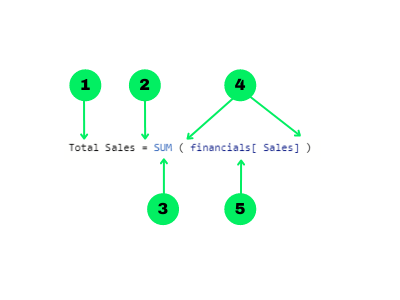What is DAX?
DAX or Data Analysis Expressions drive all the calculations you can perform in Power BI. DAX formulas are versatile, dynamic, and very powerful – they allow you to create new fields and tables in your model. DAX is a formula language used in Power BI, Power Pivot, and SSAS Tabular models
DAX formulas are made up of 3 core components, and this tutorial will cover each of these:
- Syntax – Proper DAX syntax is made up of a variety of elements, some of which are common to all formulas.
- Functions – DAX functions are predefined formulas that take some parameters and perform a specific calculation.
- Context – DAX uses context to determine which rows should be used to perform a calculation.
Why is DAX Important in Power BI?
DAX formulas allow you to get the most out of your data and Power BI to solve business problems efficiently.
You can perform simple calculations (such as a simple sum or average) and create most visuals without touching DAX. For example, if you wanted to create a simple chart showing total profit, you could drag the profit field onto the Values section of the chart, and it would perform a sum of the rows in that field. However, there are two cases where it would be better to create a DAX formula:
- If you wanted to re-use a formula in multiple places, such as in multiple charts or as an expression in other DAX formulas. In this case, using a DAX formula would make your report more efficient and easier to change in the future since you would only need to change a single formula rather than changing many individual formulas in each place they are used.
- If you wanted to create complex or customized formulas where just a simple
SUMorAVERAGEwould not be sufficient for the business problem you were trying to solve.
Master Power BI From Scratch
Where are DAX Formulas Used in Power BI?
There are three ways you can use DAX formulas in Power BI:
- Calculated Tables - These calculations will add an additional table to the report based on a formula.
- Calculated Columns - These calculations will add an additional column to a table based on a formula. These columns are treated like any other field in the table.
- Measures - These calculations will add a summary or aggregated measure to a table based on a formula.
The main difference between these three calculation types is their context (more on this later) and the outputs they produce.
To add any one of these types of calculations to a model, navigate to the Modeling tab of the ribbon. Here, you will find three choices for adding a new measure, calculated column, or table. Alternatively, you can right-click a table in the Fields pane and get the option to add a new measure or calculated column in the drop-down menu.

Start Learning Power BI For Free
DAX Functions in Power BI
How to Write a DAX Formula
DAX formulas are intuitive and easy to read. This makes it easy to understand the basics of DAX so you can start writing your own formulas relatively quickly. Let’s go over the building blocks of proper DAX syntax.

- The name of the measure or calculated column
- The equal-to operator (“=”) indicates the start of the formula
- A DAX function
- Opening (and closing) parentheses (“()”)
- Column and/or table references
- Note that each subsequent parameter in a function is separated by a comma (“,”)
DAX functions can also be nested inside each other to perform multiple operations efficiently. This can save a lot of time when writing DAX formulas. For example, it is often useful to have multiple nested IF statements or to use the IFERROR function to wrap around another function so that any errors in the formula are represented by the value you specify.
Some of the most common DAX functions used in reports are:
- Simple calculations:
COUNT,DISTINCTCOUNT,SUM,AVERAGE,MIN,MAX. SUMMARISE: Returns a table typically used to further apply aggregations over different groupings.CALCULATE: Performs an aggregation along with one or more filters. When you specify more than one filter, the function will perform the calculation where all filters are true.IF: Based on a logical condition, it will return a different value if it is true or false. This is similar to theCASE WHENoperation in SQL.IFERROR: Looks for any errors for an inner function and returns a specified resultISBLANK: This function checks if the rows in a column are blank and returns true or false. It is useful in conjunction with other functions like IF.EOMONTH: Returns the last day of the month of a given date (column reference in a date format) for as many months in the past or the future.DATEDIFF: returns the difference between two dates (both as column references in date formats) in days, months, quarters, years, etc.
Understanding Context in DAX Formulas
DAX formulas in Power BI are dynamic and change according to the context in which they were created. It’s important to understand how contexts work in DAX, as it can help save you a lot of headaches when you run into confusing errors in your formulas.
There are two main types of context in DAX: row context and filter context.
Row context
This refers to just “the current row” across all columns of a table and extends to all columns in related tables. This type of context lets the DAX formula know which rows to use for a specific formula.
Here is an example of a formula for a calculated column that has a row context:
Cost Price Per Unit = financials[COGS] / financials[Units Sold]

In this example, the Cost Price Per Unit is calculated on a row-by-row basis. This means that DAX needs to know the current row as it proceeds through the dataset, making the calculation and populating the new column with the result.
Row context is implicit in calculated columns. This is because the calculations performed in calculated columns are done on a row-by-row basis; thus, the row context is defined by default. However, this is not the case in measures since the aggregations are applied for all rows in a table. These calculations do not need to have any knowledge of a current row since all rows are aggregated together.
As an example of a measure, consider the following DAX formula:
Profit margin = SUM ( financials[Profit] ) / SUM ( financials[Sales] )
In this case, the entire Profit column is summed to produce a single number, and this is divided by the sum of the entire Sales column. DAX does not need to know the current row since it performs an aggregation. Thus, this measure has no row context.
To explicitly define a row context in a measure, you need to use a special function called an iterator. Examples of iterator functions are SUMX, AVERAGEX, and COUNTX. These functions will first perform a calculation on a row-by-row basis and then perform the final aggregation on the result (i.e., sum, average, count, etc.). In this way, the row context is defined explicitly by using these iterators.
Let’s take a look at an example of an iterator function in action:
Average Cost Per Unit = AVERAGEX ( financials, financials[COGS] / financials[Units Sold] )
This example performs two calculations: first, the expression is evaluated on a row-by-row basis, and then the result is applied to the AVERAGE function. An alternative way of reaching this same result is to first create the calculated column Cost Price Per Unit as we did above and then create a separate AVERAGE measure for that column. However, knowing when to use these iterator functions can make your reports more efficient and use less memory, as you can effectively perform two calculations using just a single formula.
Filter context
Filter context is applied on top of a row context and refers to a subset of rows or columns that are specified as filters in the report. Filters can be applied in a few ways:
- Directly in a DAX formula
- Using the filters pane
- Using a slicer visual
- Through the fields that make up a visual (such as the rows and columns in a matrix)
A good example of adding a filter context to a DAX formula is using the CALCULATE function, which allows you to add one or more filter parameters to the measure. In the example below, we create a profit margin measure filtered for the USA only:
USA Profit Margin = CALCULATE ( SUM ( financials[Profit] ) / SUM ( financials[Sales] ), financials[Country] = "United States of America")
Common Challenges and Beginner Mistakes in DAX
When learning DAX, beginners often encounter common pitfalls that can make understanding and debugging formulas more challenging. Here are some of the issues and tips to address them:
1. Confusing row and filter contexts: Many beginners struggle with distinguishing between row and filter contexts. Remember that row context refers to operations performed row-by-row (e.g., calculated columns). In contrast, filter context applies additional filters to calculations (e.g., slicers or filters in a report). Tip: Use iterator functions like SUMX or AVERAGEX to explicitly define row contexts in measures.
2. Overusing calculated columns: While calculated columns are useful, they can often be replaced by measures, which are more memory-efficient and dynamic. Creating unnecessary calculated columns can bloat your data model. Tip: Use measures whenever possible, as they are calculated on the fly, and do not permanently increase the size of your data model.
3. Neglecting proper naming conventions: Poorly named measures or calculated columns can quickly become confusing in complex reports. Tip: Adopt consistent and descriptive naming conventions to organize your DAX formulas.
4. Ignoring performance optimization: DAX formulas can become slow with large datasets if not optimized. Overcomplicated formulas or excessive use of nested functions may lead to performance issues. Tip: Use tools like DAX Studio to analyze and optimize your formulas, and consider simplifying calculations where possible.
Best Practices for Optimizing DAX Formulas
To improve the performance of DAX formulas, especially in large datasets, follow these best practices:
| Best practice | Description |
|---|---|
| Use measures over calculated columns | Measures are dynamic and calculated on demand, consuming less memory than calculated columns. |
| Avoid nested iterations | Minimize the use of complex nested functions (e.g., SUMX, AVERAGEX) to prevent performance bottlenecks. |
| Filter early | Apply filters at the data source or in DAX formulas to reduce the number of rows processed. |
| Leverage variables | Use VAR to store intermediate results and avoid redundant calculations within a formula. |
| Simplify relationships | Ensure the data model has clear relationships and appropriately indexed tables for faster processing. |
| Optimize cardinality | Reduce the number of unique values in columns used for filtering or joining to enhance performance. |
Conclusion
You now have some basic DAX tools to try out, and they are just the tip of the iceberg of all that DAX can do. With over 250 functions, the road to DAX mastery is challenging and rewarding. You can start taking your DAX skills to the next level today with our Introduction to DAX in Power BI course!
Become a Power BI Data Analyst
Master the world's most popular business intelligence tool.
FAQs
What is DAX in Power BI?
DAX or Data Analysis Expressions, allow you to perform calculations that create new fields and even new tables in your model.
What does DAX stand for in Power BI?
Data Analysis Expressions
How to write a DAX formula in Power BI?
DAX formulas are entered into the formula bar just below the ribbon in Power BI. Start by giving the formula a name and then follow with the equal-to sign (“=”). Then write in your formula using functions, constants, or strings.
How to write a DAX measure in Power BI?
Create a DAX measure by selecting ‘New Measure’ from the Modeling tab of the ribbon or by right-clicking a table in the Fields pane and selecting ‘New Measure’ from the drop-down.
How to create a ‘case when’ formula using DAX in Power BI?
The ‘case when’ formula is created using the IF function in a DAX formula.
How to join two tables in Power BI using DAX?
The easiest way to join two tables is to leverage existing relationships between the tables and use the ADDCOLUMNS function to add additional columns to a table. This function performs a left join.
How to use the where clause using DAX in Power BI?
The where clause is easily applied using filter parameters in DAX. For example, the CALCULATE function takes an expression and multiple optional filter parameters. This helps to control how charts and user input influences these functions.
How to create static tables in Power BI using the DATATABLE DAX function?
The DATATABLE function is an easy and convenient way to create static tables that do not refresh unless the DAX function is explicitly changed. The DATATABLE syntax is:
DATATABLE (
<column1_name>, <column1_datatype>,
<column2_name>, <column2_datatype>,
{
{ <value1_row1>, <value2_row1> },
{ <value1_row2>, <value2_row2> }
}
)
How to replace values in Power BI using DAX?
There are two ways to replace string values in a column using DAX and that is with the REPLACE and the SUBSTITUTE functions. The REPLACE function will replace a string based on the exact position and number of characters you specify. On the other hand, the SUBSTITUTE function will replace any exact match string, regardless of its position.
How do I learn to use DAX in Power BI?
DataCamp's DAX in Power BI. The course teaches a vast range of beginning to advanced DAX calculations and the best way to use them in your reports.


